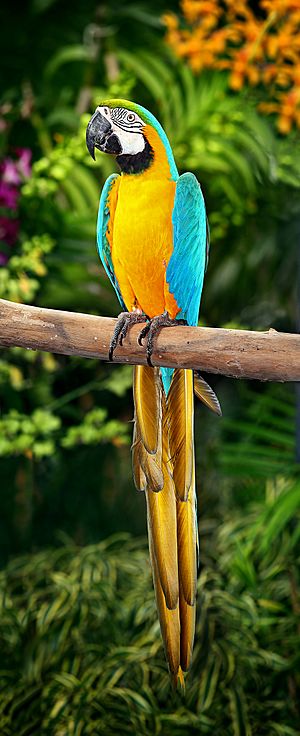True parrot facts for kids
The true parrots are a big group of about 350 different kinds of colorful birds. Most of them can fly, but a few can't. They have special curved beaks and mostly eat plants. True parrots are found all over the world, from Mexico and South America to Africa, India, Australia, and even islands in the Pacific Ocean.
You might know some of these famous true parrots:
Quick facts for kids True parrots |
|
|---|---|
 |
|
| Blue-and-yellow macaw at Jurong Bird Park | |
| Scientific classification |
|
| Kingdom: | Animalia |
| Phylum: | Chordata |
| Class: | Aves |
| Order: | Psittaciformes |
| Superfamily: | Psittacoidea Illiger, 1811 |
| Families | |
|
Psittacidae |
|
Contents
Amazing Parrot Features
True parrots have a very unique beak. It's curved, and the top part can move a little where it connects to their head. They usually sit or stand upright.
These birds are also super smart! They have a large brain for their size. Parrots are great at flying and are very good at climbing trees.
Talking and Sounds
Some parrots can even copy human voices and other sounds they hear. They don't have vocal cords like people do. Instead, they have a special organ called a syrinx at the bottom of their windpipe. This syrinx helps them make all sorts of noises.
What Do Parrots Eat?
Most true parrots mainly eat seeds. But their diet can change depending on the species. Some also enjoy fruits, nuts, leaves, and sometimes even insects. Lorikeets mostly drink nectar from flowers, and many other parrots drink nectar too.
Where Do Parrots Live?
True parrots live in warm, tropical, and subtropical parts of the world. You can find them in many different places, from wet tropical forests to dry deserts in Australia. They also live in India, Southeast Asia, Africa, and Central and South America. The biggest groups of parrots live in Australia, South America, and Central America.
Most true parrots build their nests in holes or cavities, like in trees. They usually stay with one partner for life.
Why Parrots Need Our Help
Many true parrot species are in danger. This means their numbers are getting smaller. Organizations like the International Union for the Conservation of Nature keep track of these threatened birds.
Dangers to Parrots
There are several reasons why parrots are in trouble:
- Pet Trade: People sometimes catch wild parrots to sell them as pets. Many birds do not survive being caught or transported.
- Hunting: Some parrots are hunted.
- Habitat Loss: Their homes, like forests, are being destroyed.
- New Species: Sometimes, new animals or plants come into an area and cause problems for the parrots.
Because of these issues, parrots are more affected than almost any other bird group.
What's Being Done?
There are rules and agreements, like CITES (Convention on International Trade in Endangered Species), that try to control or stop the trade of endangered animals. Most parrots are protected by these rules.
When people work to save the homes of big, well-known animals, it also helps protect many other smaller, less famous species that live in the same places.
Sadly, about 18 types of parrots have disappeared forever since the year 1500. Most of these were true parrots.
How Parrots Are Grouped
Scientists group parrots into different families. The true parrots belong to a big group called Psittacoidea. This group is one of three main groups of parrots.
The family Psittacidae, which used to include many parrots, has now been split into three main families:
- Psittacidae: These are the New World (Americas) and African parrots.
- Psittrichasiidae: These are parrots from islands in the Indian Ocean.
- Psittaculidae: These are Asian and Australasian parrots, including lovebirds.
Species Lists
- List of parrots by common or scientific name
- List of parrots by scientific grouping
Gallery
See also
 In Spanish: Psittacoidea para niños
In Spanish: Psittacoidea para niños


